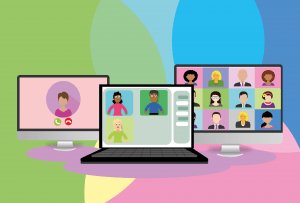Read (7 mins) or Listen (11 mins)
The initial response to the Covid-enforced campus closures can be characterised as ’emergency remote teaching’ (ERT) (see Hodges et al., 2020 for detailed discussion of this) and whilst many saw it as a great opportunity to put ‘online learning’ to the test, the rapidity of the shift and the lack of proper planning time meant that this was always going to be hugely problematic. In many ways, conflating ERT with online/ blended teaching has buttressed the simplistic narrat ives we are increasingly hearing: online = bad; in-person = good. This is a real shame but understandable in some ways I suppose. As time went on, I witnessed tons of experimentation, innovation, and effective practice informed by scholarship of teaching and learning. Each of these endeavours signified an aspect of our collective emergence from ERT towards models of online and blended teaching and learning much better aligned to research evidence and, frankly, what experienced online/blended teachers and designers had been arguing and promoting for some time. Will this be reflected in planning for 21-22 and beyond? At UCL, the perspective on the near and medium term future is being framed as ‘blended by design’.
ives we are increasingly hearing: online = bad; in-person = good. This is a real shame but understandable in some ways I suppose. As time went on, I witnessed tons of experimentation, innovation, and effective practice informed by scholarship of teaching and learning. Each of these endeavours signified an aspect of our collective emergence from ERT towards models of online and blended teaching and learning much better aligned to research evidence and, frankly, what experienced online/blended teachers and designers had been arguing and promoting for some time. Will this be reflected in planning for 21-22 and beyond? At UCL, the perspective on the near and medium term future is being framed as ‘blended by design’.
Given ongoing uncertainties AND the growing acceptance of the many opportunities for embracing many of the affordances realised by blended teaching, learning and assessment in HE (particularly in terms of inclusive practice), my feeling is that a focus on ‘by design’ is an important framing, as it counterpoints the implied panicky, knee-jerk (though necessary at the time) ERT and emphasises the positive and nuanced aspect we can now take. In other words, it’s not because of ‘forced compliance’ but because we and our students will benefit. We have more time (though it may not feel like it) to reflect on approaches that work in our disciplines and make informed decisions about how we might remain flexible whilst optimising some of the more effective and welcomed aspects of online tools & approaches and how that can be woven into how we will likewise optimise time in-person. It goes without saying (I think) that ‘blended’ learning can be many, many things but at some level seeks to combine coherently in a single programme or module in-person and online media, approaches and interactions. Such a broad, anchoring definition is helpful in my view. In an institution like UCL, one size will never fit all: we are gloriously diverse in everything so it allows for huge variation in interpretation under that broadly blended umbrella (please excuse my mashed metaphors). All I’m suggesting is we open our minds to other ways than being, and to face, head on, some of the pre-existing issues in conventional HE, especially if our inclination is to ‘get back as to how it was’ as swiftly as possible. With this in mind, I believe it is worth taking a few moments to consider our mindsets in relation to what ‘blended by design’ might mean so I offer below some thoughts to frame these reflections (as someone who has been blending for 20 years or more and has taught fully online programmes for 6 of those):
[the challenges to think about our thinking below have been developed and updated and were originally published as an infographic here]
1. Reality Check
In our enthusiasm to do our best by our students, it is easy to forget that much of what we have done over the last year was catalysed by a global pandemic. We are still learning as we are doing and the fact that students did not necessarily sign up for an education in this form brings all sorts of new demands to both teacher and student. Whilst it is important to listen to and understand frustrations arising from this, we should also recognise th at blending our teaching and assessment practices offers some new potentials but that the workload and emotional demands we have all faced could cloud our perceptions. One positive aspect to think about as we start reflecting, is that most of us are building on what we did last year so the resource development for many of us should be significantly reduced (for example re-use of recorded lectures). The same applies to essential digital skills development and a growing understanding of what constitutes effective practice in blended modes. The following points all seek to underscore these as we plan for next year.
at blending our teaching and assessment practices offers some new potentials but that the workload and emotional demands we have all faced could cloud our perceptions. One positive aspect to think about as we start reflecting, is that most of us are building on what we did last year so the resource development for many of us should be significantly reduced (for example re-use of recorded lectures). The same applies to essential digital skills development and a growing understanding of what constitutes effective practice in blended modes. The following points all seek to underscore these as we plan for next year.
2. What experienced blended practitioners will tell you
The ‘content’ is best made available asynchronously. Students need orienting to clear, inclusive, signposted and accessible resources and activities that are, where possible, mobile-friendly. Face to face time is NOT best used for didactic teaching. Building a community is fundamental. There are a number of points here but all are fundamentals to consider when blending by design. In fact, they’re so important, it may be useful to re-frame them as questions:
a. Is most of the content available asynchronously in the form of audio, video, text? 
b. Is that stuff accessible? Not only accessible in terms of inclusive practice but consistently designed, presented and organised so things can be found easily and students know what to do when they get there? So, for example, do videos come with instructions on how much to watch, what to look out for, how to approach the video, how the information will be followed up/ used/ applied?
c. Are face to face sessions (web-mediated or in “meatspace”) optimised for exchange/ dialogue/ discussion/ questioning/ interaction?
d. What have you done pre-programme, pre-module, pre-session and within each module/ session to build community?
3. Different starting point; different focal point
(To generalise massively!) Content as ‘king’ drives a lot of learning design in HE but, whilst it remains fundamental (of course), we need to reconsider its pre-eminence. Students who have chosen a campus degree are craving on-campus time but we need to be alert to what is being craved here: The company of peers; the proximity of experts. Instead of framing our thinking and actions based on a big lecture or lengthy ‘delivery’ and knowledge-based outcomes we need to open multiple channels of communication first. Another way of looking at this might be to consider typical prior learning experiences and other influencers on expectations of a ‘higher ‘ education. Most, if not all, of our students will know how to approach conventional teaching (a room, focussed on 1 person at the front, usually with a board) and can adapt to environments that have disciplinary specificity (labs, field work) because these fall within their expectations. New pedagogic approaches and differing or unexpected modalities challenge them to learn to ‘be’ in those spaces. We need to guide them. It may seem obvious to us but until we spell out ways of being in novel environments through our words and modelled actions we may be disappointed with levels of engagement.
fundamental (of course), we need to reconsider its pre-eminence. Students who have chosen a campus degree are craving on-campus time but we need to be alert to what is being craved here: The company of peers; the proximity of experts. Instead of framing our thinking and actions based on a big lecture or lengthy ‘delivery’ and knowledge-based outcomes we need to open multiple channels of communication first. Another way of looking at this might be to consider typical prior learning experiences and other influencers on expectations of a ‘higher ‘ education. Most, if not all, of our students will know how to approach conventional teaching (a room, focussed on 1 person at the front, usually with a board) and can adapt to environments that have disciplinary specificity (labs, field work) because these fall within their expectations. New pedagogic approaches and differing or unexpected modalities challenge them to learn to ‘be’ in those spaces. We need to guide them. It may seem obvious to us but until we spell out ways of being in novel environments through our words and modelled actions we may be disappointed with levels of engagement.
4. C Words
If social communication is fostered first then opportunities for collaboration, creation and co-creation linked to the content and in an uncertain and unfamiliar context are more likely to follow.
5. What’s your portal?
Your Virtual Learning Environment may be the logical launch point for your resources but as you integrate other tools and settings (webinars? labs? visits? video content? social media?) you may find your are posting notifications and guidance in lots of places. Stick with one portal and launch all from there. Students need to know where to go.
integrate other tools and settings (webinars? labs? visits? video content? social media?) you may find your are posting notifications and guidance in lots of places. Stick with one portal and launch all from there. Students need to know where to go.
6. No point recreating the wheel (as they say)
Before you make a resource or record a video check to see whether: a. You have done something before you could adapt b. Colleagues have something or are working on something similar or c. You can find something you could use in whole or part online. Find clear ways to link to/ share these and signpost explicitly. There’s a big difference between simply posting a few YouTube links and weaving directions, narratives and questions around those videos and then sharing them of course.
you could adapt b. Colleagues have something or are working on something similar or c. You can find something you could use in whole or part online. Find clear ways to link to/ share these and signpost explicitly. There’s a big difference between simply posting a few YouTube links and weaving directions, narratives and questions around those videos and then sharing them of course.
7. Golden rules
With ‘flipped’, self-access content that students will discuss/ use/ apply later you should be thinking of short, bite-size chunks of information. What are the ‘threshold concepts’? Don’t worry about high-end production in the first instance or the odd cough or interruption – these are both expected and human. If you have curated a lot (see previous point) think even more about how and when students will connect with you.
8. On and off campus connections
Whether time and space for face to face meeting is available or not, office hours, tutorial times, feedback slots and seminars need scheduling. The more this can be factored in the better. NOT scheduling lecture watching time makes sense (offers choice/ flexibility etc) but recognising that things work better within weekly chunks as far as planning activity and making connections is concerned. So, for example, I might ask students to watch videos on topic X sometime on Monday or Tuesday before attending an applied lab session on the Wednesday (I need to find out if there is research data on this as this is purely from personal experiences). With groups who are geographically widespread, fostering time-zone specific communities of practice will really help.
feedback slots and seminars need scheduling. The more this can be factored in the better. NOT scheduling lecture watching time makes sense (offers choice/ flexibility etc) but recognising that things work better within weekly chunks as far as planning activity and making connections is concerned. So, for example, I might ask students to watch videos on topic X sometime on Monday or Tuesday before attending an applied lab session on the Wednesday (I need to find out if there is research data on this as this is purely from personal experiences). With groups who are geographically widespread, fostering time-zone specific communities of practice will really help.
9. If you care they know it!
Insecurities students have about completing studies, technical abilities, time available etc. can be ameliorated significantly when we use time to connect, to show willing, to be available. No-one expects teachers to be online/blended education experts overnight but there is a growing expectation that we will have learned from the inspiring (and bitter) lessons of the last year or so and reflect that in the way we design and facilitate teaching, learning and assessment.
ameliorated significantly when we use time to connect, to show willing, to be available. No-one expects teachers to be online/blended education experts overnight but there is a growing expectation that we will have learned from the inspiring (and bitter) lessons of the last year or so and reflect that in the way we design and facilitate teaching, learning and assessment.
10. By design
To acknowledge, reflect on and then act accordingly means we are doing ‘by design’. Starting with the principles above is actually a lot further ahead than the initial, thrown together responses many were obliged to adopt last year. The blend is inevitable but a pedagogically- informed, compassionate and effective blend is more desirable.

